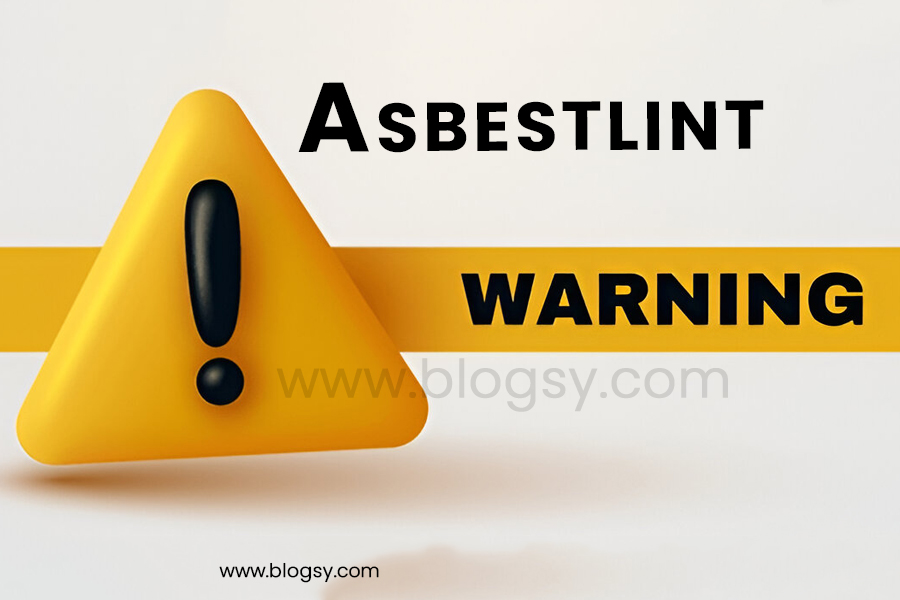
Asbestlint is a term that blends “asbest,” referring to asbestos, with “lint,” the tiny dust and fiber particles that often collect in homes, workplaces, and industrial areas. Essentially, asbestlint describes microscopic asbestos fibers mixed with lint-like particles, making them even easier to spread through the air. This invisible mix can pose serious health risks when inhaled, as asbestos exposure is strongly linked to lung diseases, cancers, and other respiratory issues.
Understanding what asbestlint is, how it forms, and why it matters can help you take better precautions at home, work, and in the environment. In this article, we’ll explore asbestlint in detail—covering its sources, health dangers, prevention, removal methods, and the growing importance of awareness.
Understanding Asbestlint
The term asbestlint may sound unusual, but it highlights an important issue. Lint is usually associated with laundry dryers, clothing fibers, or dust balls that collect around the house. When asbestos is present in older building materials or insulation, tiny fibers can break loose and become airborne.
If these fibers combine with everyday lint, they create asbestlint—a mixture that looks harmless but carries toxic potential. Unlike visible dust, asbestlint is microscopic, which makes it harder to detect without specialized equipment. Recognizing the difference between regular lint and asbestos-laden fibers is crucial for both safety and prevention.
The Nature of Asbestlint
Asbestlint doesn’t have a single appearance, because it is essentially a combination of two different materials: fibrous asbestos particles and soft lint fibers. Asbestos itself is a naturally occurring mineral made up of needle-like crystals, which are durable and resistant to heat. When they break down, the resulting fragments can cling to other fibers, such as clothing lint or household dust.
Together, they create an almost invisible hazard that can float in the air for hours. This ability to remain suspended and undetected makes asbestlint particularly dangerous, since people may inhale it without realizing it.
Health Risks Linked to Asbestlint
Exposure to asbestlint is not the same as breathing in harmless dust. When asbestos fibers enter the lungs, they can embed deep into tissue and remain there for decades. Over time, this can lead to severe health conditions such as asbestosis, mesothelioma, and lung cancer. Unlike common allergies or irritations caused by dust, the health risks from asbestlint are long-term and often irreversible.
Even small, repeated exposures add up, making it essential to minimize any contact. For workers in construction, renovation, or manufacturing industries, the risks are even higher because asbestos particles may be released more frequently in these environments.
Sources of Asbestlint in Daily Life
Many people assume asbestos is only a concern in factories, but it can appear in unexpected places. Old insulation, vinyl tiles, roofing shingles, and cement products often contain asbestos. When these materials age, crack, or are disturbed, fibers may be released and mix with ordinary household lint.
Laundry is another overlooked source, especially if work clothes contaminated with asbestos are washed at home. Lint traps in dryers can collect these fibers and redistribute them into the air. Similarly, industrial machinery and demolition sites can produce large amounts of asbestlint if safety precautions aren’t followed.
How Asbestlint Spreads
Asbestlint spreads far more easily than most people realize. Air circulation systems, such as HVAC units, can pull in asbestos fibers and circulate them throughout an entire building. Simple household cleaning methods, like vacuuming with non-HEPA filters or shaking out dusty fabrics, can also release and scatter asbestlint into the air.
In industrial environments, cutting, sanding, or drilling asbestos-containing materials often leads to fiber dispersal. Because asbestlint particles are light and microscopic, they can linger in the air for extended periods before settling, making them easy to inhale unintentionally.
Detecting Asbestlint
Detecting asbestlint isn’t straightforward because it doesn’t have a distinctive look or smell. Unlike visible lint or dust bunnies, asbestos fibers are microscopic and can only be confirmed through laboratory testing. Homeowners may notice unusual amounts of dust or fibers in older buildings, but visual inspection alone is not enough.
Professional asbestos inspectors use specialized equipment and sampling methods to identify the presence of asbestos. For safety reasons, testing should always be done by certified experts rather than DIY attempts, since improper handling can release even more fibers into the air.
Preventing Exposure to Asbestlint
The best way to stay safe from asbestlint is prevention. Regular household cleaning using HEPA-filter vacuums can reduce lint particles, but they won’t eliminate asbestos if it’s present in building materials. Protective measures, such as wearing masks, gloves, and disposable clothing, should be followed during renovations or when handling suspicious materials.
Avoid disturbing older structures without proper assessment. If you suspect asbestos, leave the material undisturbed and contact a professional removal service. Educating family members and workers about the dangers of asbestlint is also a key step toward minimizing exposure risks.
Regulations and Safety Standards
Governments around the world have strict regulations regarding asbestos, and by extension, asbestlint. In the U.S., the Environmental Protection Agency (EPA) and Occupational Safety and Health Administration (OSHA) provide guidelines for handling and disposing of asbestos safely. In Europe and other regions, similar safety standards exist to protect both workers and the public.
These regulations cover everything from workplace exposure limits to building codes that restrict asbestos use. Understanding and following these rules ensures compliance and helps reduce the risks associated with asbestlint in residential and industrial settings alike.
Comparison: Asbestlint vs. Regular Lint vs. Asbestos Dust
| Feature / Aspect | Regular Lint | Asbestlint | Pure Asbestos Dust |
|---|---|---|---|
| Safe for Health | ✔️ | ❌ | ❌ |
| Visible to the Eye | ✔️ | ❌ | ❌ |
| Stays Airborne Long | ❌ | ✔️ | ✔️ |
| Found in Modern Homes | ✔️ | ✔️ (older homes with asbestos) | ❌ (mainly in old construction) |
| Causes Severe Diseases | ❌ | ✔️ | ✔️ |
| Easy to Clean Safely | ✔️ | ❌ | ❌ |
| Requires Professional Removal | ❌ | ✔️ | ✔️ |
Professional Removal and Management
When it comes to asbestlint, professional removal is the safest option. Asbestos abatement experts follow strict procedures to seal off contaminated areas, use negative air pressure systems, and wear protective equipment. The process typically involves wetting the materials to reduce airborne fibers, carefully removing them, and disposing of waste in approved facilities.
While professional removal can be costly, it is far safer than DIY attempts, which often release more asbestos particles. Investing in expert help not only protects your health but also ensures legal compliance with asbestos disposal regulations.
Environmental Impact of Asbestlint
Asbestlint doesn’t just affect human health—it can also harm the environment. When asbestos particles settle in soil, they can remain there for decades without breaking down. Rain and runoff may carry fibers into water systems, contaminating rivers, lakes, and even groundwater. Wildlife exposed to these particles may experience respiratory damage similar to humans.
In urban areas, improper asbestos removal can pollute entire neighborhoods, affecting air quality for years. Because asbestos is non-biodegradable, managing its spread is crucial to protect ecosystems and maintain safe living environments for future generations.
Myths and Misconceptions About Asbestlint
One of the biggest misconceptions about asbestlint is that small exposures don’t matter. In reality, there is no safe level of asbestos exposure, and even minor contact can accumulate into serious health risks over time. Another myth is that asbestos is only found in old buildings, but it still exists in certain products and imported materials.
People also tend to believe lint itself is harmless, yet when combined with asbestos fibers, it becomes a dangerous contaminant. Addressing these misconceptions helps raise awareness and encourages proper safety practices in households and workplaces.
Future of Asbestlint Awareness
The future of asbestlint awareness looks promising as more research sheds light on its dangers. Safer building materials are being developed to replace asbestos entirely, reducing the likelihood of future contamination. Public health campaigns are also improving understanding of asbestos-related risks, urging property owners to test older structures.
Technology may soon allow faster, more affordable detection of asbestos particles, making it easier to identify hazards early. Ultimately, spreading awareness about asbestlint empowers individuals, families, and communities to take proactive steps toward safer environments.
Conclusion
Asbestlint may not be a widely recognized term, but it represents a very real hazard that blends two everyday materials: asbestos fibers and lint particles. This seemingly harmless mixture can spread through homes, workplaces, and industrial environments, putting anyone who inhales it at risk.
From severe lung diseases to long-term environmental impacts, the dangers of asbestlint are too serious to ignore. By understanding what it is, recognizing its sources, and following prevention and removal strategies, individuals can protect themselves and their loved ones. The key lies in awareness, education, and proactive safety measures.
FAQ
1. What is asbestlint?
Asbestlint is a mix of asbestos fibers and lint particles, making it a hidden but dangerous air contaminant.
2. Is it harmful?
Yes. Inhaling asbestlint can cause serious diseases like lung cancer, mesothelioma, and asbestosis.
3. Where does it come from?
It often comes from old insulation, ceiling tiles, dryer lint traps, and contaminated work clothes.
4. How can I tell if lint has asbestos?
You can’t see it with the naked eye. Only certified asbestos testing can confirm asbestlint.
5. Can I clean myself?
No. DIY cleaning spreads fibers. Always call professional asbestos removal services.
6. How do I prevent exposure to asbestlint?
Avoid disturbing old materials, use HEPA vacuums, and rely on experts for safe removal.
Don’t miss out on any news—keep in touch for real-time information, visit: Blogsy.!



